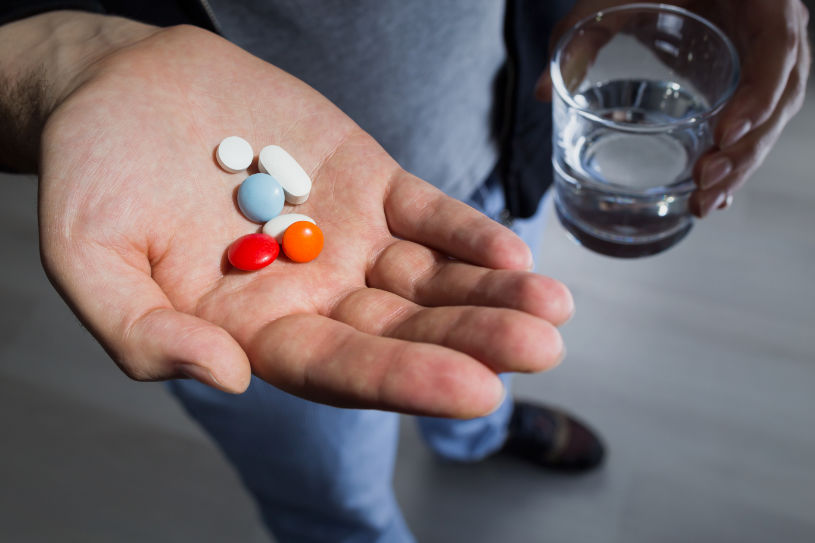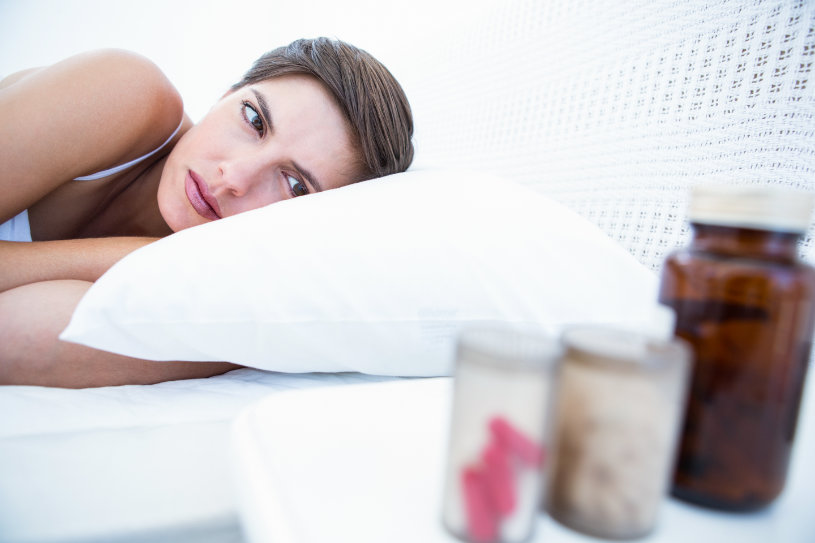Methocarbamol is a commonly prescribed muscle relaxer used for pain and spasms. It works by stimulating the central nervous system to impede pain sensations from being transmitted to the brain. The drug was first manufactured in the 1950s and is marketed under the generic form Robaxin. It is available as a prescription-only drug in the US, though it is sold as an OTC in Canada.
Table Of Contents:
Methocarbamol uses also include opiate withdrawal and the treatment of tetanus. People asking what is its mechanism of action and whether Methocarbamol is a narcotic should understand that Methocarbamol (Robaxin) does not fall in this category. This, however, does not mean that one cannot be addicted to the medication. Addicts should contact health officials or rehab centers to help with the management of Methocarbamol withdrawal symptoms. Read on to find out the health effects of Robaxin addiction and withdrawal symptoms.
High doses of Robaxin drug may have the potential to cause addiction in some people.
More About Muscle Relaxants:
What Is Methocarbamol?
Trade name: Robaxin®
Generic name: Methocarbamol
Methocarbamol is a centrally-acting skeletal muscle relaxant (SMR) commonly used to manage and treat acute musculoskeletal pain. This medication does not act directly on the muscles, but instead, it’s believed it exerts its effects on the central nervous system (CNS), causing depression.
Methocarbamol’s exact mechanism of action is not fully understood, but it is believed to inhibit nerve impulses or pain sensations that are sent to the brain. By dampening these signals, Methocarbamol helps to relieve muscle tension and discomfort, allowing for improved mobility and reduced pain. It is important to note that Methocarbamol does not treat the underlying cause of muscle pain but rather provides symptomatic relief.
Methocarbamol drug’s class is skeletal muscle relaxant. This means that the muscle relaxer works in the spinal cord or brain to block down or dampen excessively stimulated nerve pathways. That’s why Robaxin can also be called a CNS depressant. Thus, it works in the body by blocking pain sensations. This is achieved by blocking the nerve impulses that are sent to a person’s brain when they experience pain symptoms. By blocking these impulses, a person is likely to find that the muscle pain they experience starts to decline.
Is Methocarbamol A Controlled Substance?
Even though Robaxin is not a controlled substance under the Controlled Substances Act (CSA), it belongs to prescription-only medication and can’t be bought without a valid prescription in the U.S. Meanwhile in Canada Methocarbamol over the counter can be easily found, albeit in a lower dose.
Methocarbamol Brand Name
It is important to recognize all names used to refer to the active chemical. The drug is marketed under different brands depending on whether it is fused with other active ingredients. It is sold as Robaxin in places like the US, UK, and Canada. In Germany, it is marketed under the brand name Ortoton while Lumirelax is the brand for France. The version of the medicine mixed with the active substance acetaminophen is marketed under Tylenol and Robaxacet. When it is mixed with Ibuprofen, it is sold as Robax Platinum. The version which contains Aspirin is called Robaxisal in the US and Canada. However, in Spain Robaxisal is known as Robaxacet. All these medications are efficient at pain treatment, however, be sure to consult a medical doctor before administering them to avoid serious health implications.

What Is Robaxin Used For?
The Methocarbamol pill falls under the skeletal muscle relaxant drug class and is mainly used as a painkiller and for the treatment of back pain and spasms. The medication works on the central nervous system to help tight muscles relax. It was approved for use in the treatment of lumbago by the FDA in 1959. Some manufacturers mix the drug with other active ingredients to improve efficacy and to treat other types of pain. For instance, Tylenol which is mixed with the active ingredient acetaminophen is useful in treating mild to moderate pains such as menstrual pains, toothache, and headaches. Below are other FDA approved Methocarbamol uses.
Robaxin For Back Pain
One of the most common Methocarbamol uses is in the management of back pain. A study of Robaxin, which was performed to evaluate its efficiency, concludes that Robaxin for back pain is an efficient and balanced option for treating acute lower back pain and neck pain. Compared to other medicines, Robaxin is a less sedating alternative. The pill is the only approved muscle relaxant approved by the European Medicines Agency for lower back pain. This is because other muscle relaxants like tetrazepam were withdrawn due to unfavorable risk-benefit factors. However, it is not advisable to combine taking this drug with alcohol. This is because it is a CNS depressant and taking it with alcohol may have dire consequences.
Methocarbamol For Tetanus
Robaxin can also be used to treat tetanus. Clinical tests suggest that the neuromuscular manifestations of tetanus can be controlled by Methocarbamol. In a study, it was discovered that when muscle relaxants were used to help treat tetanus patients, there was a heavy improvement in the recovery rate. There was a major reduction between spasms and complications were greatly reduced. However, it does not replace the regular procedures and medicines used to treat tetanus like debridement, penicillin, and tetanus antitoxin.
Off-Label Methocarbamol Uses
Though Methocarbamol (Robaxin) is used as a musculoskeletal relaxant it can also be a helpful supplemental medication. Here are some off-label Methocarbamol uses: myofascial pain, fibromyalgia, inflammatory arthritides, acute and non-specific low back pain, rib fractures, perioperative care of knee and hip replacements, and abdominal muscle cramps in patients with cirrhosis. In the past, the Methocarbamol pill was useful in treating tetanus, but that has been replaced by benzodiazepines. Note that the medication is ineffective in the treatment of rigidity, contracture, or spasticity which emanates from an injury to the upper motor neuron. In the case of any of these medical conditions, contact a physician for help.
Methocarbamol For Opiate Withdrawal
Some people may ask whether the Methocarbamol pill works for opiate withdrawal. Since it is also known to be a central nervous system depressant, as it has sedating properties, it relaxes the mind and the body. Hence people often use the medication to ease their opiate withdrawal symptoms, such as anxiety, insomnia, gastrointestinal distress, restless leg syndrome (RLS), muscle aches and pains. The use of Methocarbamol has proven to be quite beneficial when treating opiate withdrawal symptoms for most people. However, sometimes it has no effect or could even give an adverse reaction. Therefore it should always be used under a doctor’s supervision.
Methocarbamol For Sleep
Since Robaxin possesses sedative properties, it eases the mind and relaxes the body and is therefore sometimes used to induce sleep. This helps in alleviating the symptoms of insomnia and restlessness, thus improving one’s sleep.
Methocarbamol For Headache And Migraine
Robaxin is known as an effective painkiller. It works by stopping pain-related sensory signals from reaching the brain and so it is also used to treat headaches, in addition to just back pain. Studies have shown that migraines cause muscle contractions, that is why some people rub their temples to feel some relief. CNS depressants do not work directly on the muscles. They work on the nerve endings and, therefore, the brain mechanisms of migraines, which is why a Robaxin pill may be used to treat migraines.
Methocarbamol For Anxiety
People often ask, does Robaxin work for anxiety? A central nervous system depressant works by relaxing the nerves in the body. This is why muscle relaxants like methocarbamol and ibuprofen are used for anxiety relief and may be given before surgical procedures that may cause stress and anxiety.
Robaxin for Fibromyalgia
Patients with fibromyalgia suffer from musculoskeletal pain in different parts of their bodies. Fibromyalgia affects the way the brain perceives pain signals by amplifying them. CNS depressants such as Robaxin help calm the nervous system by blocking these signals from reaching the brain and therefore it is proven to be useful for fibromyalgia patients as well.
Stopping Robaxin use should be done gradually, and with medical guidance to avoid relapse.
Robaxin Abuse Overview: Is Methocarbamol Addictive?
When looking at the potential of Methocarbamol abuse, it is important to focus on previous studies that have been conducted on this subject. Fortunately, a few scientific trials have provided the evidence. While Robaxin abuse is not as likely as with narcotics or opioid painkillers, studies show that this is still a possibility that needs to be kept in mind when using the drug.
Is Robaxin addictive? In asking this question, people need to consider the dose of the drug that they are taking. This is one particularly important factor that seems to play a role. Furthermore, Methocarbamol addiction also seems to depend on whether a person has a history of substance abuse. Overdosing on the medicine may come about as a result of combining it with alcohol. This may in turn lead to addiction. It is, therefore, advisable for patients to stay off alcohol while administering this medicine.
Methocarbamol addiction must be taken seriously according to the study conducted by researchers at the Johns Hopkins University School of Medicine. During the research, people were divided into three groups. One group received a daily dose of Methocarbamol. A second group received Lorazepam and a third a placebo drug. Lorazepam had the most significant effect in terms of potential for abuse. The study found, however, that those who took Methocarbamol (Robaxin) also showed signs of addiction when the dose of the drug was increased.

Methocarbamol Abuse Statistics
Methocarbamol abuse is possible due to its habit-forming quality. The drug’s relaxing effects can lead people to misuse the drug. Also, higher dosages of the medication can be abused by people who have a history of substance abuse. Overdosing and misusing the drug can lead to Methocarbamol addiction. Available data indicates that the abuse of skeletal muscle relaxants tripled between 2005 and 2016. To avoid this, it is imperative to take the drug strictly according to the medical doctor’s prescription. Methocarbamol withdrawal is possible so addicts should seek help only at a recognized health center.
Signs and Symptoms Of Methocarbamol Abuse
Recognizing the symptoms of Robaxin abuse is vital. This can help a loved one realize that a person is developing an addiction to the pills. It can also help the individual identify the issue and take action before matters get more serious. When a person takes a Methocarbamol tablet too frequently, it is not only the addiction that needs to be taken into account but also the adverse effects of the drug on their body. Generally, Robaxin abuse signs would be similar to other prescription drugs.
Psychological Changes Caused By Robaxin Abuse
On a behavioral level, there will be a change in a person’s lifestyle and habits. Recognizing addictive behavior is a crucial step to help a person with Robaxin abuse problems. Since Robaxin works on the central nervous system, its abuse can have dangerous effects on the psychological level. This may lead to drastic changes in the behavior of the abuser. A typical symptom of abuse is dysphoria; a feeling of dissatisfaction with life. Dysphoria may result in paranoia and anxiety. Other behavioral changes that may be noticed when Robaxin abuse take place include:
- Lethargy
- Depression
- Irritability
- Aggression
A person may also start to skip their regular activities and avoid meetings with family members. Addicted people could potentially end up mixing with criminals and other people that they do not usually hang out with.
Physical Robaxin Abuse Symptoms
A person may also complain about severe Robaxin side effects when they abuse the drug. This can be a physical sign associated with the abuse of a muscle relaxant Robaxin. People who abuse the medicine will sometimes experience side effects like these:
- Rapid heart rate
- Slow heart rate
- Flushing
- Fever
- Blurred vision
- Dizziness
- Coordination issues
- Stomach pain
- Mood fluctuations
- Fainting
If one or more signs from this list were present in a loved one, it is recommended to contact a medical doctor to discuss further addiction treatment and therapy to ensure a smooth withdrawal and detoxification therapy.
Who Is Most At Risk Of Methocarbamol Abuse
Robaxin has a low potential for abuse compared to benzos, however, users can abuse it by taking higher doses of the medication. People who have a history of abusing drugs, especially narcotics, are at risk of abusing Robaxin. To avoid abuse be sure to exercise self-control and strictly follow the doctor’s prescription. People who abuse the medication may contact rehab centers to help with withdrawal symptoms.
Robaxin Withdrawal And Detox
A person who is abusing Robaxin should enroll in a professional treatment program run by a rehab center to overcome the addiction. The initial treatment phase generally includes a period of detoxification. During the detox period, some people may experience Methocarbamol withdrawal symptoms. During this time, there are some adverse reactions that may appear in a person. Some of them may be painful, but the great thing about Robaxin withdrawal is that most people will not experience severe Robaxin withdrawal symptoms when they are tapering off under the proper medical guidance. There are no real withdrawal symptoms, however, patients who are using the drug to treat pain may start experiencing the pain once the medication begins to wear off. Side effects include vomiting, slow or fast heart rate, mood fluctuations, and fainting. Patients need to stay off alcohol while undergoing detoxification therapy.
Individuals need to understand what to expect when they undergo the detoxification program to help eliminate the drug from the system. It is also vital to consider stopping Robaxin should be done gradually. Going cold turkey on withdrawal can be more severe in some people. The best advice is to contact a rehabilitation center where the patient will undergo therapy.
Treatment Of Methocarbamol Addiction
When a person has developed an addiction to Robaxin, it can be troublesome. Whether it is Methocarbamol 750 or any higher dose, the habit can cause severe health damage. Except for the dosage factor, Methocarbamol interactions should also be taken into consideration. Since the drug is often still taken for some period, using other drugs along with Robaxin can sometimes be dangerous. Don’t try to substitute the drug with alternatives or mix it with other medications without a doctor’s permission.
The risk of Methocarbamol abuse seems to be significantly higher in people who have a history of abuse with narcotics and similar substances. Thus, professional treatment is generally considered the best option. Stopping Robaxin use should be done gradually, and with medical guidance to avoid relapse. Also, a person will be monitored by a professional treatment team. This also gives them access to advice and assistance during their recovery period. Methocarbamol drug tests can also be done to determine when the active chemicals found in the medicine have been effectively eliminated from their bodies. When severe Robaxin side-effects occur, professional rehab also gives the person access to staff that can assist in reducing the effects of these adverse events.
Hope Without Commitment
Find the best treatment options. Call our free and confidential helpline
Most private insurances accepted
Page Sources
- Drug Bank. (n.d). Methocarbamol: Uses, Interactions, Mechanism of Action. Drug Bank. https://go.drugbank.com/drugs/DB00423
- S. Abd-Elsalam. (2018) Methocarbamol in Treatment of Muscle Cramps in Cirrhotic Patients. US National Library of Medicine: Clinical Trials https://clinicaltrials.gov/ct2/show/NCT02642874
- MedlinePlus.(n.d). Acetaminophen. MedlinePlus. https://medlineplus.gov/druginfo/meds/a681004.html
- R. Lezzard, A. Potvin, Y. Morin. (1960). Use of Methocarbamol in Tetanus. Experimental and Clinical Approach. PubMed. https://pubmed.ncbi.nlm.nih.gov/13761177/
- C. Anah. (1974). Tetanus: Conservative Management Made Easier By Combination of Muscle Relaxants. Pubmed. https://pubmed.ncbi.nlm.nih.gov/4451234/
- Sciencedirect. (n.d). Tetrazepam - an overview. Sciencedirect. https://www.sciencedirect.com/topics/pharmacology-toxicology-and-pharmaceutical-science/tetrazepam
- Sciencedirect. (n.d). Methocarbamol - an overview. Sciencedirect. https://www.sciencedirect.com/topics/neuroscience/methocarbamol
- S. See, PharmD, R. Ginzburg, PharmD. (2008). Choosing A Skeletal Muscle Relaxant. American Family Physician. https://www.aafp.org/afp/2008/0801/p365.html
- Minneapolis Clinic of Neurology. (n.d). Headaches/Migraine. Minneapolis Clinic of Neurology.https://minneapolisclinic.com/patient-resources/headaches/
- University of Massachusetts Medical School. (n.d). Understanding and Managing Fibromyalgia. University of Massachusetts Medical School. https://www.umassmed.edu/globalassets/office-of-continuing-medical-education/pdfs/cme-primary-care-days/c1-fibromyalgia.pdf
- K. Preston, J. Guarino, W. Kirk, R. Griffiths. (1989). Evaluation of The Abuse Potential of Methocarbamol. National Library of Medicine: National Center for Biotechnology Information. https://www.ncbi.nlm.nih.gov/pubmed/2703967
- Rehab Center. (n.d). Methocarbamol (Robaxin) Abuse and Addiction. Rehab Center. https://www.rehabcenter.net/methocarbamol/
- University of Pennsylvania School of Medicine. (2020). Long-term Use of Muscle Relaxants Has Skyrocketed since 2005. Science daily. https://www.sciencedaily.com/releases/2020/06/200626092721.htm
- K. Preston, J. Guarino, W. Kirk, R. Griffiths. (1989). Evaluation of The Abuse Potential of Methocarbamol. The Journal of Pharmacology and Experimental Therapeutics.https://jpet.aspetjournals.org/content/248/3/1146.long
- H. Waldman MD. (1994). Central Acting Skeletal Muscle Relaxants and Associated Drugs. Sciencedirect. https://www.sciencedirect.com/science/article/pii/0885392494901996
- M. Liebowitz, MD, D. Klein, MD. (1979). Hysteroid Dysphoria. Psychiatric Clinics.https://www.psych.theclinics.com/article/S0193-953X(18)30996-1/fulltext
- C. Sannerud, N. Ator, R. Griffiths. (1991). Methocarbamol: Evaluation of Reinforcing and Discriminative Stimulus Effects. PubMed.https://pubmed.ncbi.nlm.nih.gov/11224058/
- O. Emrich, K. Milachowski, M. Strohmeier. (2015). Methocarbamol in Acute Low Back Pain. A Randomized Double-Blind Controlled Study. PubMed. https://pubmed.ncbi.nlm.nih.gov/26168743/

 Authored by
Authored by  Reviewed by
Reviewed by 
